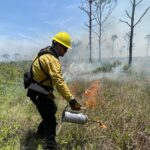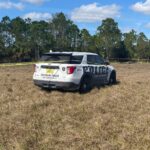By Larry Macke
FELLSMERE — If Congressman Bill Posey has his way, Indian River County will lead the charge to replace the rallying cry of “drill, baby, drill” in the search for new energy sources with the much more environmentally friendly “grow, baby, grow.”
The congressman was in Fellsmere Tuesday touring the PetroAlgae research and development facility to call attention to clean energy alternatives being developed on the Space and Treasure coasts.
“A lot has happened here in the past year, and I’m very happy with what I see,” said Posey, who visited the PetroAlgae in 2008. “You keep on keeping on, and I’ll keep doing what I can to make sure that you get a fair shake in Washington (in attempting to get federal funding for clean energy initiatives.)”
Melbourne-based PetroAlgae was founded in 2006 to develop and license commercial micro-crop technology systems that enable production of green diesel using rapid-growth, fuel-producing organisms such as algae. In addition to being heavy consumers of carbon dioxide, micro-crops of algae are viewed as a more commercially and environmentally promising fuel source than macro-crops such as corn and soybeans, which take longer to grow and demand greater use of irrigation, fertilizers, and pesticides.
The PetroAlgae tour featured briefings by company founder John Scott and Bill Grieco, vice president of engineering, who outlined for Posey the process of growing, harvesting, and processing the algae to produce a bio crude product that can be processed by existing oil refineries into fuel.
“This is a fuel that introduces no new CO2 into the environment because the CO2 that is burned is the CO2 that is absorbed by the algae,” explained Scott. “Fossil fuels sometimes are referred to as ancient biomass, and what we have here is new biomass.”
A primary reason for the improved commercial viability of microcrops is the fact that macrocrops typically can be harvested only a few times per year, whereas algae can be harvested a few times per day. Microcrops also fare better in terms of the ratio of energy spent in production of the fuel to energy created.
“Ethanol has a renewability ratio of between .7 and 1 to 1 versus between 1.5 and 2.5 to 1 for microcrops,” said Grieco, “which means about twice as much energy is created as is consumed.”
After the tour, Posey greeted PetroAlgae employees and praised their efforts. The Fellsmere facility currently employs 45, ranging from hourly manual laborers to PhD-level scientists, and the figure is expected eventually to rise to 125.
The visit was part of a day-long tour of local clean energy technology facilities in the 15th Congressional District. Other scheduled stops included the Advance Magnet Lab in Palm Bay and the Florida Solar Energy Center in Cocoa. Posey also had toured the Fellsmere facility last September during his campaign run.





